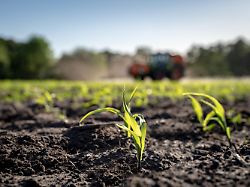Six ideas for healthy soil
This is what agriculture of the future will look like
December 13, 2023, 9:02 a.m
Listen to article
This audio version was artificially generated. More info | Send feedback
Global food production threatens the earth: it depletes soils, causes species to die, the rainforest to burn and fuels climate change. But that doesn’t have to be the case. There have long been ways and means for sustainable agriculture. Six examples of what food production could look like in the future.
Fake meat
Experts around the world are crafting meat that doesn’t contain any animals. In kettles, not unlike those in breweries, bacteria, algae and fungi grow as protein suppliers. Elsewhere, plant-based ingredients made from soy, peas and wheat are mixed together – and very successfully: soy steak and tofu nuggets can be bought in almost every major supermarket. The latest generation of fake meat, mostly made from pea protein, is so similar to its animal counterparts that hardly anyone can taste the difference during blind tastings.
Regenerative agriculture
Nature has incredible self-healing powers – if you just let it. This is exactly what regenerative agriculture aims to achieve. Unlike organic farming, it not only aims to preserve and protect soils and ecosystems, but even improve them. She uses methods such as no-till (avoiding plowing) or direct sowing, which increase soil quality and biodiversity.
But the claim is holistic. In every corner of a farm you observe closely how the community of living beings is made up and what can be planted where in harmony. It’s about understanding farms as a cycle again, and this also includes animals and livestock farming: when straw becomes feed, manure becomes fertilizer, fertilizer becomes crop and new straw, the cycle that the global agricultural economy has interrupted is closed.
Direct seeding
When direct sowing, there is no need to dig up the soil. Instead, after the harvest, catch crops are planted on the rotting residue, such as legumes, which increase the nitrogen content in the soil and thus make less artificial fertilizer necessary. In spring these cover crops are chopped off.
Now it’s time for direct sowing: special machines create furrows a few centimeters deep in the cover of organic material into which the seeds of the main crop land. In between, undersown crops are often planted that push out weeds and do not leave any gaps in the field. Insects and birds snack on this additional food supply. This means that the field is constantly overgrown or covered, the soil remains protected against water loss and wind and receives new nutrients.
Precision Farming
A strange fleet jerks across the fields of the world: agricultural robots, sometimes large and box-shaped like a refrigerator, sometimes small and delicate like toys. They spray herbicides as sparingly as perfume, shoot laser beams at weeds or use gear wheels to till the ground next to rows of crops. They are part of the precision agriculture that experts expect to revolutionize the field.
Smaller agricultural machinery can make large tractors obsolete and enable healthier fields with more biodiversity. Precision methods also give us eyes and ears where we would otherwise have none: sensors in the ground measure how high the pH value is, and satellites in the air detect how much biomass plants produce. In the end, an AI could decide when to water.
Mob grazing
It may not seem logical, but grass sprouts better if it is eaten away from time to time. It compensates for the loss above ground through increased root growth, also to displace competing plants. Side effect: The soil becomes richer in nutrients and species and stores more greenhouse gases.
Cattle, goats and sheep can go from climate killers to climate protectors – if they stand close together and only graze briefly on one pasture. This is called “mob grazing” because the animals attack the land like a mob, kicking seeds into the ground, fertilizing them with their excrement and then disappearing. In some regions of Africa, mob grazing is trying to stop desertification.
Keyline design
You can also help the soil directly beneath the topsoil: In the 1950s, Australian engineer Percival Alfred Yeomans invented a method to conserve rare rainwater on his farm in the hills of New South Wales. He identified “keypoints” where the soil best stores water and topographic “keylines” that correspond to the direction of flow. Along these key lines he loosened the soil 20 to 30 centimeters deep, lifting it slightly. The plants formed deeper roots and had better access to nutrients and water. The fertile soil grew several centimeters per year. Yeoman’s “Keyline design” is now seen as a real opportunity to arm agriculture against climate change.
